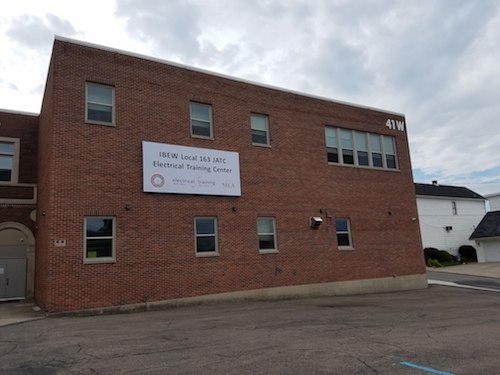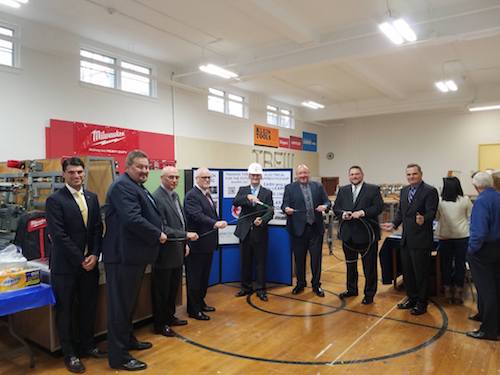It didn’t take a
miracle for members of
Wilkes-Barre,
Pa., Local 163
to turn a closed Catholic school into an IBEW-NECA joint training
facility, but leaders hope the building’s holy vibes will continue to bless the
work being done inside.

|
| Wilkes-Barre, Pa., Local 163 members upgraded the former St. Stanislaus Elementary School to make it a code-compliant, state-of-the-art training center.
|
“We looked at several commercial properties, warehouses and storefronts” as potential sites, said Local 163 Training Director John Nadolny. “That’s how we found St. Stanislaus.”
Located in a residential neighborhood in Nanticoke, a Wilkes-Barre suburb with a population of about 10,000, St. Stanislaus once served as an elementary school operated by the Roman Catholic church of the same name just across the street.
Lots of IBEW locals train members in spaces ranging from available spare rooms in union halls to large, custom-built facilities designed to suit a particular of requirements. But recycling a closed school into a training facility is something of a rarity, Nadolny said — he had only heard of similar projects in Chicago and San Francisco.
In its heyday, Nanticoke was a bustling coal mining town that boasted six Catholic churches, several of whom operated elementary schools, high schools or both. St. Stanislaus, built in the 1930s, closed its school in 2004, and for a few more years, the building continued to see some occasional use — for example, as a meeting space for the local Knights of Columbus chapter, as a haunted house for Halloween, or as a food pantry and homeless shelter.
As time went on, though, activities at the school grew less and less frequent, leaving the building to sit unoccupied and unused for extended periods and making it a tempting target for vandalism. Broken windows were common, Nadolny said, and the Diocese of Scranton eventually put the property up for sale.
“We got the school at a good price,” Nadolny said. “It was a good deal for all involved.”
The two-story structure was a near-perfect fit for the hands-on training needs of Local 163 and the its partners with the region’s National Electrical Contractors Association chapter, said Nadolny, who also serves as director of the Wilkes-Barre Joint Apprenticeship and Training Committee.

|
| Pictured at the opening of the new training center are (from left) Wilkes-Barre Joint Apprentice Training Committee (WBJATC) Trustee Robert Bresnahan, IBEW Third District International Representative Randy Kieffer, IBEW Third District International Vice President Mike Welsh, WBJATC Chairman Joseph Cavanaugh, Pennsylvania State Senator John Yudichak, Local 163 Business Manager John Olejnik, Pennsylvania State Representative Gerald Mullery, and National Electrical Contractors Association Penn-Del-Jersey Chapter Executive Director Jeffrey Scarpello.
|
And although St. Stanislaus did not require costly retrofits, he said, the structure wasn’t quite move-in ready immediately after the sale was finalized.
“No walls needed to be knocked down,” Nadolny said, “but it needed some work to make it ADA compliant, and the wiring needed to be completely redone.” Local 163 members took care of handling those projects, as well as thoroughly cleaning the building and installing modern LED lighting outside.
The gymnasium on the school’s main floor provides a large open area that can be divided into two classrooms as needed. There also are five standard elementary school classrooms upstairs plus extra training space in the basement.
“We preserved and refinished all of the woodwork in the classrooms,” Nadolny said. “We also use the original chalkboards. They work well for our theory calculations.”
The brick building is solid, Nadolny said — so solid that, when the local tried to set up wireless internet service inside, members needed to install 12 separate Wi-Fi hotspots. The signal from just one could not be counted on to reliably penetrate the thick interior walls and provide good coverage for wireless devices, he said.
Three nights a week, about 60 apprentices attend three-hour technical training classes at St. Stanislaus, in addition to the education they get from working on contract jobs. Apprentices in the program can receive up to 60 college credits over the course of the five-year training program.
Twelve Local 163 journeymen wiremen serve as instructors at the St. Stanislaus facility. “We have specialists in every discipline,” Nadolny said.
“The neighbors are thrilled to have the school being used,” he said. “And the diocese is thrilled that we’re using it to train people for careers.”
Nadolny recently told Wilkes-Barre’s The Citizens’ Voice that the training center is a valuable resource because the hard work of an electrician is not for everyone.
“It’s very dangerous work,” he said. “We teach them how to be safe.”
There is a big demand for electricians, Nadolny said, and the best candidates, of course, are skilled, knowledgeable and dependable.
“We’ve never had a deficiency of interest in classes,” Nadolny said.
The paper noted that the U.S. Department of Labor projects a 9 percent rise in the need for electrician employment by 2026.
“This isn’t a job,” Nadolny said. “It’s a career.”
Local 163’s Mark Gatusky, one of the training center’s students, told the Citizen’s Voice that he had wanted to be an electrician since he was a child. He added that his father, uncles and both grandfathers were IBEW electricians with Local 163.
The 37-year-old Gatusky, who is in the final year of his five-year apprenticeship, decided to follow his dream after spending several years in an office job.
“I found myself much happier doing this and working with my hands,” said Gatusky, who told the paper that he has worked at natural gas power plants, a water park, and Allentown’s PPL Center arena. “It’s a creative way to make a living. No day is the same.”